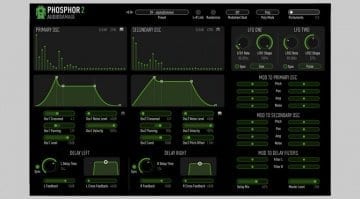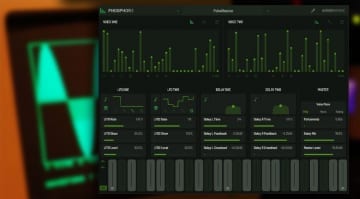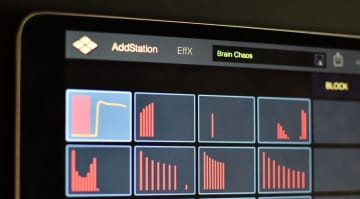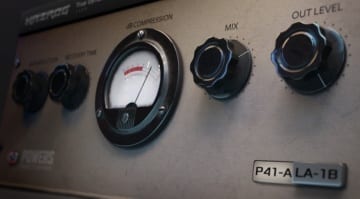Phosphor 2 models the vintage additive synthesis of alphaSyntauri
Audio Damage have released a new and updated version of their 2011 model of alphaSyntauri. Phosphor 2 brings this classic additive software synthesizer back to life so we can all enjoy its unappreciated 80’s-ness.
alphaSyntauri
You’ve never heard of it either, right? The alphaSyntauri was Syntauri corporations answer to the Synclaviar and Fairlight. It was billed as the first affordable digital synthesizer at around $1500, as compared to the $40,000 Fairlight. This was achieved by using the Apple IIe (not included) as the processing platform.
It was an 8-bit additive synthesizer with 16 digital oscillators, 16 voices and 8 parts multitimbral. Sounds were generated by the combination of 16 sine waves or “partials”. There was not a whole lot going on in terms of modulation or filtering. There was an ADSR envelope but that was about it. Although it wasn’t a sampler you could use sampled waveforms in the oscillators.
As it ran on a more regular computer various bits of additional software emerged for it. “alphaPlus” gave access to 10 instruments, some parameters and keyboard splitting. “MetaTrak” brought in a 16 track multi-timbral sequencer. The were wave editors and wave drawing, like with the Fairlight, provided you had the Apple light pen. Syntauri Corporation folded in 1984.
More information on the alphaSyntauri along with images and videos can be found on the Encyclotronic website.
Phosphor 2
Audio Damage found one somewhere that they could use to create the original Phosphor. This update brings it back up to date with a clearer interface and the oscillators have been “totally reworked”. There’s also an iOS version in the works.
It features two oscillators with the original collection of 16 partials plus the option for 32 or 64. Each oscillator has its own envelope. That’s the main thrust of the original instrument, everything else is modern enhancements. The partials can be run in “lo-fi” mode for that authentic gritty digital sound or you can clean them up as pristine, alias-free sines. You can similarly mix in lo-fi or hi-fi noise, which feels like an odd statement. Audio Damage have built in two complete delay sections with LP/HP filtering and cross-feedback. And then there are two LFO’s that can be routed all over the place.
They finish it off with a large range of presets including those classic ones from the original. I’ve read that most of the presets were completely terrible but every now and then an awesome lead or organ sound would emerge. Hopefully Audio Damage have stuck with the awesome ones.
It’s a quite unique, brash and fiercely digital sounding instrument. Audio Damage have done a great job of extending its life and surrounding it with the right sort of processing and modulation. Phosphor 2 is available now for $59 in VST, VST3, AU, AAX and soon to be iOS. More information on the Audio Damage website.
Phosphor 2 is available now for $59 in VST, VST3, AU, AAX and soon to be iOS. More information on the Audio Damage website.





